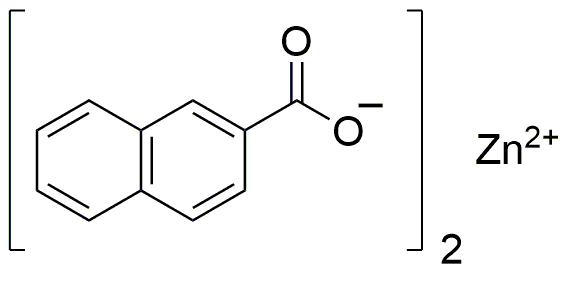Zinc naphthenate is widely utilized in research focused on various practical applications across multiple industries. Here are five notable uses:
- Wood Preservation: This compound is commonly used as a wood preservative, protecting against fungal decay and insect damage. It enhances the longevity of wooden structures, making it ideal for outdoor applications.
- Coatings and Paints: Zinc naphthenate serves as a drying agent in paints and coatings, improving their performance and durability. It helps in accelerating the drying process, which is crucial for industrial applications.
- Agricultural Applications: In agriculture, it acts as a micronutrient supplement, providing essential zinc to crops. This is vital for plant growth and development, particularly in zinc-deficient soils.
- Rubber Industry: The compound is used as a catalyst in the vulcanization process of rubber, enhancing the strength and elasticity of rubber products, which is beneficial for manufacturing tires and seals.
- Corrosion Inhibitor: Zinc naphthenate is effective in preventing corrosion in metal surfaces, making it valuable in various industrial applications, including marine and automotive sectors.
General Information
Properties
Safety and Regulations
Applications
Zinc naphthenate is widely utilized in research focused on various practical applications across multiple industries. Here are five notable uses:
- Wood Preservation: This compound is commonly used as a wood preservative, protecting against fungal decay and insect damage. It enhances the longevity of wooden structures, making it ideal for outdoor applications.
- Coatings and Paints: Zinc naphthenate serves as a drying agent in paints and coatings, improving their performance and durability. It helps in accelerating the drying process, which is crucial for industrial applications.
- Agricultural Applications: In agriculture, it acts as a micronutrient supplement, providing essential zinc to crops. This is vital for plant growth and development, particularly in zinc-deficient soils.
- Rubber Industry: The compound is used as a catalyst in the vulcanization process of rubber, enhancing the strength and elasticity of rubber products, which is beneficial for manufacturing tires and seals.
- Corrosion Inhibitor: Zinc naphthenate is effective in preventing corrosion in metal surfaces, making it valuable in various industrial applications, including marine and automotive sectors.
Documents
Safety Data Sheets (SDS)
The SDS provides comprehensive safety information on handling, storage, and disposal of the product.
Product Specification (PS)
The PS provides a comprehensive breakdown of the product’s properties, including chemical composition, physical state, purity, and storage requirements. It also details acceptable quality ranges and the product's intended applications.
Certificates of Analysis (COA)
Search for Certificates of Analysis (COA) by entering the products Lot Number. Lot and Batch Numbers can be found on a product’s label following the words ‘Lot’ or ‘Batch’.
*Catalog Number
*Lot Number
Certificates Of Origin (COO)
This COO confirms the country where the product was manufactured, and also details the materials and components used in it and whether it is derived from natural, synthetic, or other specific sources. This certificate may be required for customs, trade, and regulatory compliance.
*Catalog Number
*Lot Number
Safety Data Sheets (SDS)
The SDS provides comprehensive safety information on handling, storage, and disposal of the product.
DownloadProduct Specification (PS)
The PS provides a comprehensive breakdown of the product’s properties, including chemical composition, physical state, purity, and storage requirements. It also details acceptable quality ranges and the product's intended applications.
DownloadCertificates of Analysis (COA)
Search for Certificates of Analysis (COA) by entering the products Lot Number. Lot and Batch Numbers can be found on a product’s label following the words ‘Lot’ or ‘Batch’.
*Catalog Number
*Lot Number
Certificates Of Origin (COO)
This COO confirms the country where the product was manufactured, and also details the materials and components used in it and whether it is derived from natural, synthetic, or other specific sources. This certificate may be required for customs, trade, and regulatory compliance.


